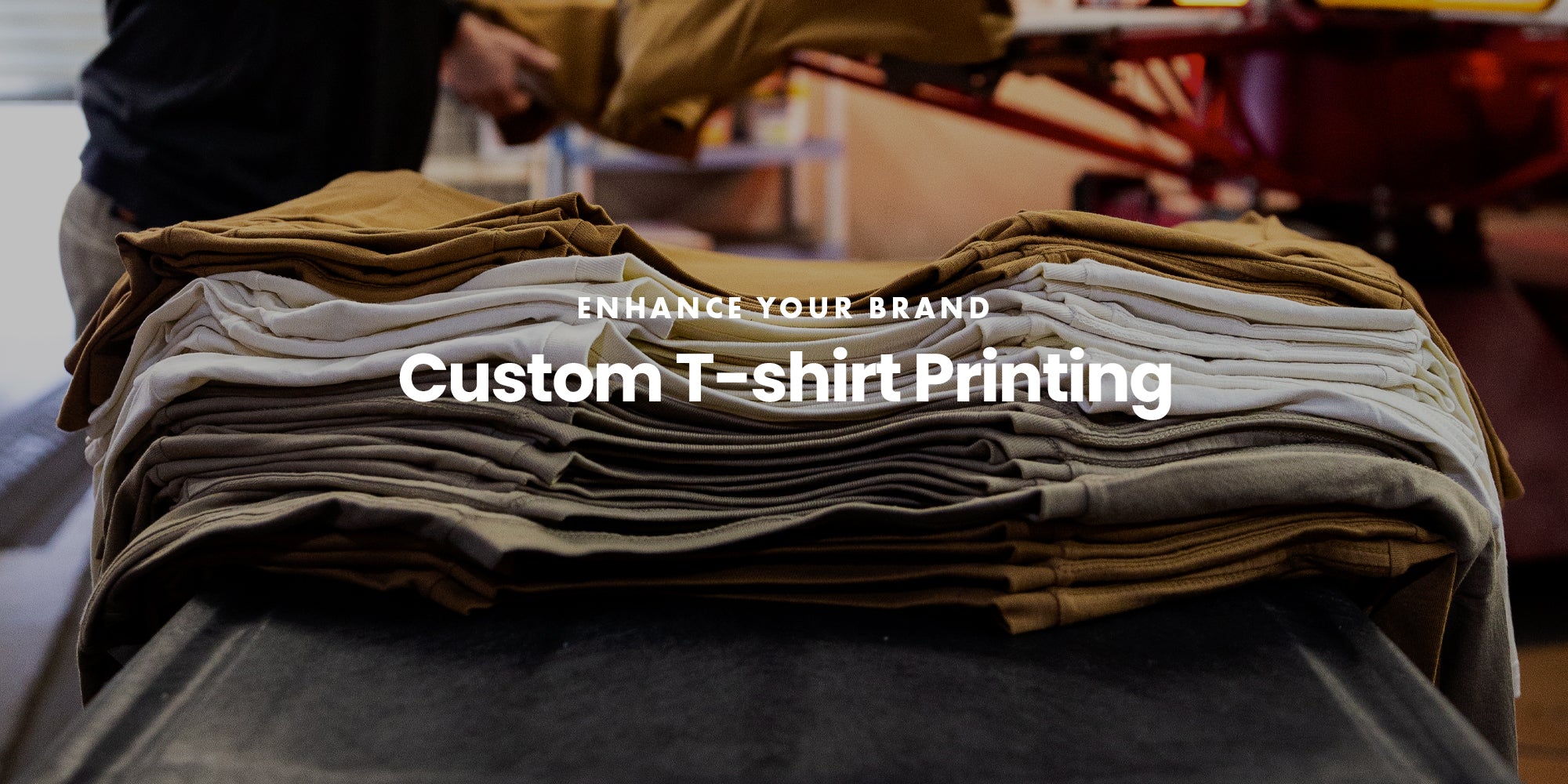Professional Screen Printing Kit for Custom Apparel
Professional Screen Printing Kit for Custom Apparel
Blog Article
Screen Printing Uncovered: Whatever You Need to Know Concerning Tee Shirt and Garment Printing Techniques
If you've ever before asked yourself just how those vibrant designs wind up on your favorite t-shirts, you're in the right location. Display printing is a remarkable approach that incorporates art with strategy, providing unlimited possibilities for creativity. Comprehending the basics, from devices to ink options, can significantly affect your outcomes. All set to check out the necessary components that make screen publishing an art kind? Allow's discover the information that can boost your jobs.
The Fundamentals of Screen Printing: Exactly How It Functions
When you plunge into display printing, you'll uncover it's both a science and an art. At its core, display printing involves creating a pattern, or display, that allows ink to travel through only in specific locations (screen printing kit). You begin by choosing your layout and preparing your screen with a light-sensitive solution. When you expose this solution to light, it hardens, leaving your design as an unfavorable space.
Setting the display over the fabric, then make use of a squeegee to press ink with the screen onto the garment. Each action is crucial, and grasping them will raise your screen printing abilities, transforming basic garments into unique, expressive items.
Sorts Of Screen Printing Techniques
When you grasp the fundamentals of display printing, it's time to discover the numerous methods that can elevate your designs. One prominent technique is typical screen printing, where ink is pushed through a stenciled display. This method is excellent for vibrant, vibrant colors. After that there's water-based ink printing, which provides a softer feel and is green, yet it requires a different method to treating.
Another choice is plastisol printing, understood for its resilience and vibrant colors, making it a preferred for numerous brand names. Experiment with halftone printing to develop slope effects and complex designs.
Important Tools for Display Printing
To achieve magnificent cause display printing, having the appropriate equipment is basic. First, you'll require a sturdy display printing frame, which holds the mesh that moves your design onto the garment. Next off, purchase high-grade squeegees; these are necessary for applying ink uniformly throughout the screen. You'll additionally require an excellent direct exposure unit to create your displays, as well as a washout booth for cleaning them after use. A reputable heat source, like a conveyor clothes dryer or warmth press, is vital for healing your prints to guarantee durability. Do not forget an appropriate workspace, furnished with tables and storage space for your products. Safety gear, such as masks and gloves, will keep you risk-free from chemicals and inks. With the right tools, you'll be well on your way to creating professional-quality prints.
Picking the Right Inks and Materials
When choosing inks and products for display printing, you require to take right into account the kind of ink that works best for your job. Think of textile compatibility to assure your layouts look last and excellent lengthy. Likewise, check out environmentally friendly ink options to make your printing procedure extra lasting.
Types of Screen Inks
Picking the appropriate display ink is vital for achieving dynamic, resilient prints that satisfy your job's requirements. There are several types of screen inks to take a look at. Specialized inks, such as metallic or glow-in-the-dark, can include distinct impacts to your designs.

Fabric Compatibility Considerations
Recognizing material compatibility is vital for accomplishing top quality display prints, particularly since various products react distinctively to various inks. Constantly check your inks on sample textile to ensure they adhere appropriately and maintain color honesty. In addition, keep in mind that material weight and structure can affect the final result, so choosing the right ink and material combination is vital for your task's success.
Eco-Friendly Ink Options
Environmentally friendly inks are coming to be a popular choice for screen printers that wish to lessen their ecological effect while maintaining high quality. When picking inks, think about water-based inks, which are less unsafe and simpler to tidy up contrasted to conventional solvents. These inks bond well with textiles, delivering lively results without hazardous chemicals. You may also discover eco-solvent inks that use fewer unstable organic substances (VOCs), making them a much safer option for both your health and wellness and the earth.
Additionally, look for inks made from renewable energies, such as soy or vegetable-based choices. By choosing the best inks and products, you'll not just develop stunning designs yet additionally add to an extra sustainable printing process. Make the button, and your prints will certainly mirror your dedication to the setting!
Preparing Your Style for Display Printing

Submit Format Demands
To assure your design looks vibrant and sharp on textile, you'll require to pay attention to file style demands for display printing. Begin with vector files like AI or EPS, as they can be scaled without losing top quality. If you utilize raster photos, decide for high-resolution data, such as TIFF or PNG, preferably at 300 DPI. Prevent making use of JPEGs, as they can lose clearness when resized. Make certain your design has a transparent history to avoid undesirable white sides on your prints. Maintain shade settings in mind; CMYK is typical for display printing, so transform your RGB develops as necessary - screen printing kit. By following these standards, you'll establish your artwork up for an effective print.
Shade Splitting Up Strategies
Shade separation is a necessary action in preparing your style for screen printing, and mastering it can significantly improve your print high quality. You'll need to break your layout right into specific shades, as each color needs a different screen throughout printing. Beginning by recognizing all the colors in your style and produce layers for each one. You can use software like Adobe Photoshop or Illustrator to separate and different shades properly. Be particular to conserve each layer as a separate documents, generally in a format like TIFF or important source PSD. This accuracy not just guarantees exact shade depiction however also streamlines the printing procedure. By focusing on shade separation, you'll achieve vivid and specialist outcomes in your screen-printed garments.
Resolution and Dimension
Accomplishing the most effective lead to screen printing starts with guaranteeing your design has the appropriate resolution and size. Ideally, your art work needs to be at the very least 300 DPI (dots per inch) for sharp, clear prints. If you utilize reduced resolution, your end product might look pixelated and amateur.
When it involves size, take into consideration the measurements of your print area. Style your artwork to match the last print dimension, ideally producing it in the real measurements you'll be printing. In this manner, you'll stay clear of any unforeseen scaling concerns.
Always inspect your style in both vector and raster layouts. Vector graphics can be scaled without shedding top quality, making them excellent for screen printing. Preparing correctly will ensure your style looks impressive on every garment!
Step-by-Step Screen Printing Process
Screen printing is a dynamic process that enables you to develop vibrant designs on various surfaces. To get going, you'll need a screen, emulsion, and your selected ink. Prepare your screen by cleaning it completely. Next off, apply the emulsion evenly and allow it dry in a dark area. When dry, reveal your screen to light with your design put on it, which will certainly set the solution where the light hits, developing a pattern - screen printing kit.
After rinsing the unexposed emulsion, your display prepares. Establish it up on your printing surface area and align your garment under it. Put ink onto the display and make use of a squeegee to push the ink with the pattern onto the textile. i loved this Lift the screen meticulously and let the print completely dry. Heal the ink utilizing heat to assure longevity. That's it! You have actually efficiently screen printed your layout.
Tips for Effective Screen Printing Projects
While you're diving right into your screen printing projects, bear in mind that prep work is vital to success. Begin by gathering all your products-- inks, garments, screens, and mops. A clean work area assists prevent undesirable mistakes, so neat up prior to you start.
Following, verify your art work is high-resolution and appropriately sized for your garment. Test your screen for appropriate exposure and clean it extensively to prevent smudges. When mixing your inks, comply with the producer's standards to achieve the ideal uniformity.
During printing, use even pressure with your squeegee for regular results. Do not hurry; take your time to confirm each print satisfies your requirements. After printing, let your garments dry entirely prior to dealing with or packaging them.
Lastly, constantly maintain content a sample of your help future referral. By doing this, you can examine your progress and enhance your techniques over time. Pleased printing!

Regularly Asked Inquiries
How much time Does It Take to Set up a Screen Printing Task?
Establishing a screen printing work commonly takes around half an hour to an hour. You'll prepare the displays, mix inks, and readjust journalism. The time varies based upon intricacy and experience, so remain arranged!
Can I Publish on Different Textile Enters Making Use Of the Very Same Method?
Yes, you can print on various fabric types utilizing the exact same strategy, but you'll need to readjust your inks and setups. Some materials take in ink differently, so exploring guarantees the very best outcomes for each and every material.
What Are Common Errors to Prevent in Display Printing?
When screen printing, avoid typical errors like utilizing the incorrect ink, disregarding appropriate exposure times, or avoiding pre-press checks. Constantly test your setup and maintain tidy screens to guarantee top quality results each time.
Exactly How Can I Appropriately Tidy and Keep My Display Printing Tools?
To appropriately clean and preserve your display printing tools, you must routinely wash screens with proper solvents, check squeegees for wear, and guarantee all devices are stored dust-free and dry. Uniformity stops costly repair work and boosts performance.
Is Display Printing Eco-friendly Compared to Other Techniques?
Screen printing can be extra eco-friendly than various other techniques, particularly if you make use of water-based inks and eco-conscious materials. By selecting sustainable materials and techniques, you decrease waste and lessen your influence on the world.
Display Printing Uncovered: Everything You Need to Know Concerning Tee Shirt and Garment Printing Strategies
At its core, display printing includes creating a pattern, or display, that permits ink to pass through just in particular locations. Position the screen over the textile, after that utilize a squeegee to press ink via the screen onto the garment. One preferred technique is standard screen printing, where ink is pressed through a stenciled screen.When selecting inks and materials for display printing, you need to take into account the type of ink that works ideal for your project.
Report this page